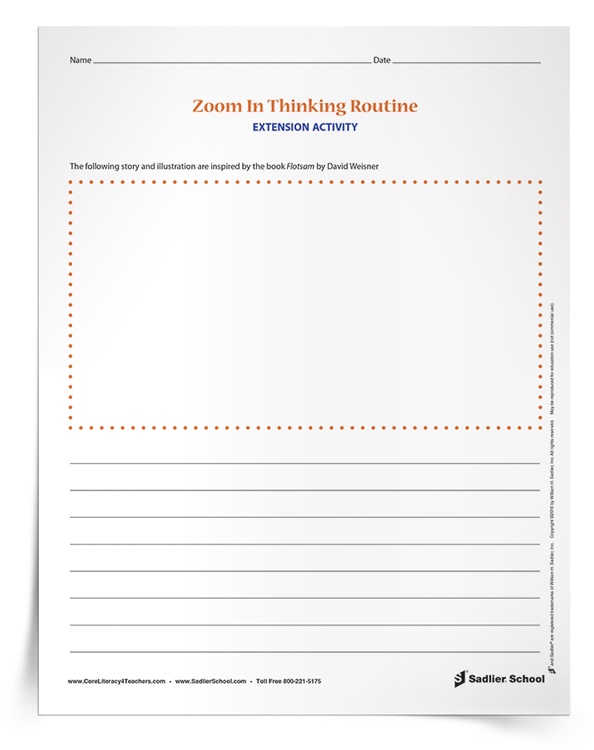February 19, 2016 CL Teaching Strategies Pro Reads, ELA PD - Literacy, ELA PD - Thinking Routines, ELA K-5, ELA Focus - Reading, ELA Resources - Graphic Organizers, Core Literacy
Make Thinking Visible with the Zoom In Thinking Routine; A Professional Development Series
By: Erin Lynch
In January, I began what will be an ongoing monthly post describing a 'thinking routine' from the book Making Thinking Visible: How to Promote Engagement, Understanding and Independence for All Learners by Ron Ritchhart, Mark Church and Karin Morrison. If you are already familiar with my previous posts discussing this book, scroll down to the Thinking Routine of the Month section, if this is your first time seeing my posts on this topic here is what you missed...
Last June, you might have read a post where I shared a few books that I thought would make good summer reading material. The professional book I suggested was: Making Thinking Visible: How to Promote Engagement, Understanding and Independence for All Learners by Ron Ritchhart, Mark Church, and Karin Morrison.
 Here is a brief synopsis of the book: Beginning at Harvard's Project Zero, Visible Thinking is a research-based approach to teaching students thinking skills. Visible Thinking is about teaching students “thinking routines" to improve thinking and comprehension abilities. By making thinking visible students can discuss and reflect on their own thinking, as well as, the thinking of their peers. Through reflective thinking and discourse a deeper understanding of the topic or subject should increase.
Here is a brief synopsis of the book: Beginning at Harvard's Project Zero, Visible Thinking is a research-based approach to teaching students thinking skills. Visible Thinking is about teaching students “thinking routines" to improve thinking and comprehension abilities. By making thinking visible students can discuss and reflect on their own thinking, as well as, the thinking of their peers. Through reflective thinking and discourse a deeper understanding of the topic or subject should increase.
We used Making Thinking Visible: How to Promote Engagement, Understanding and Independence for All Learners by Ron Ritchhart, Mark Church, and Karin Morrison as a book study at my school last year. I enjoyed the book because I have always considered that my job as a literacy specialist is to teach students strategies that will allow them to better comprehend literature. Making Thinking Visible has been a valuable resource because the book models "thinking routines." These are specific routines to use with students in order to increase their understanding of a topic and make thinking visible.
How Teachers Can Make Thinking Visible
If you are a teacher, these “thinking routines” are an excellent way to help your students deepen their comprehension. The book divides the “thinking routines” into three categories:
1. Routines for Introducing and Exploring Ideas
2. Routines for Synthesizing and Organizing Ideas
3. Routines for Digging Deeper into Ideas
There are 21 “thinking routines” suggested in the book, with seven in each of the three categories. Every month I will highlight a “thinking routine” from Making Thinking Visible and how I have used it with my classes. This month I am sharing: See–Think–Wonder.
How Principals Can Make Thinking Visible
If you are a principal, this text would be a great choice for a school-wide professional book study and/or a staff development project. Not only would you provide your staff with an invaluable resource, you will most likely increase the level of thinking within the student body. Here's how it will benefit you personally:
-
As you do school walk-throughs or observations, Making Thinking Visible will give you something to target as you enter classrooms.
-
By focusing on the “thinking routines” you should find that your teachers observations are easier, because the staff will know what is expected of them.
-
It will also help you provide feedback to your staff as you focus specifically on the “thinking routines.”
Thinking Routine of the Month: Zoom In
This month I’m highlighting the Zoom In thinking routine. I use this routine with my students to encourage them to look more deeply for information, to let them know that it is alright to change or modify their thinking as they gain new information, and — most importantly — to really examine texts and images closely before reaching a final conclusion.
Introducing the Zoom In Thinking Routine to Students
 My favorite book to use when introducing this routine is Flotsam by David Wiesner. I select one of the images in this magnificent, wordless picture book and slowly reveal the illustration while following the Zoom In prompts below:
My favorite book to use when introducing this routine is Flotsam by David Wiesner. I select one of the images in this magnificent, wordless picture book and slowly reveal the illustration while following the Zoom In prompts below:
- Tell your students to look closely at a small bit of an image that is revealed. Ask your students:
- What do you see or notice?
- What is your hypothesis or interpretation of what this might be based on what you are seeing?
- What new things do you see?
- How does this change your hypothesis or interpretation? Has the new information answered any of your “wonders” or changed your previous ideas?
- What new things are you wondering about?
- Repeat the reveal and questioning until the whole image has been revealed. Ask your students:
- What lingering questions remain for you about this image?
This introductory activity is always a big hit, so my class usually ends up doing the Zoom In thinking routine with several illustrations from the book. The extension activity is to have students select one of the illustrations in the book to draw, adding their own twist. Finally, have students write a short story about the illustration with my simple Zoom In Thinking Routine Activity. These visuals and stories make a great bulletin board.
Download the Zoom In story and illustration activity template to use with your students!




